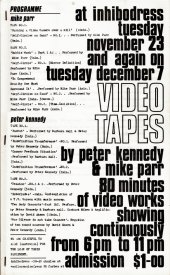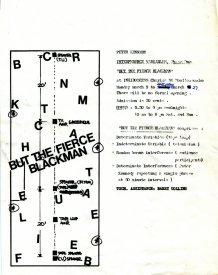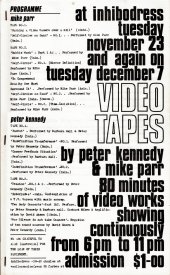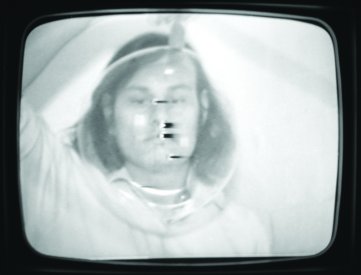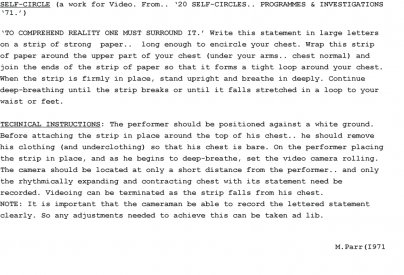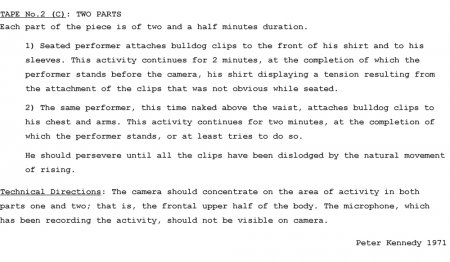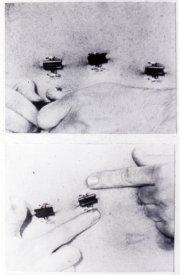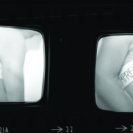Inhibodress was an important artist-run space in Sydney in 1971-72, set up by Mike Parr, Peter Kennedy and Tim Johnson and showed mostly conceptual work. The idea for the gallery was initiated by Mike Parr when he called a meeting in August 1970 to establish an artists’ run space that would focus on installation and conceptual art. It was to be a space in which as Parr put it “situations and ideas are formed.”1
A debate about the object in art, the nature of quality and other re-constructions of what art should be had been running since the later 1960s, perhaps best represented in the opposing arguments of Clement Greenberg and Donald Brook in their respective Power Lectures of 1968 and 1969. Brook had espoused a “flight from the object” and this had been taken up by many of the newer artists of that moment. For example Peter Kennedy had been working with the way light functioned within the gallery space almost as though the whole white cube itself were being painted. Parr had been developing a series of textual works that amounted to a kind of performative concrete poetry and Tim Johnson had been experimenting with the creation of situations of risk as well as, while travelling in Europe, carrying out a series of small conceptual performances which he then photographed.
Tim Johnson, Peter Kennedy and a number of other artists joined with Parr in the project but after the first few months there was a waning of interest among many of the original group of artists as they completed their shows. However Parr, Kennedy and Johnson kept the place going, making from it an important site for the most radical of art at the time, including not only their own works but the experimental music of David Ahern’s AZ Music and Teletopa, Philippa Cullen’s dance work and others such as Bruce Copping’s net of string installation (July, 1971 – see Yellow TV).
Several important conceptual pieces were constructed over the first months of Inhibodress’s existence and it produced a serious impact on the art critical scene in Australia.2
Parr showed his concrete textual works Word Situations I (March 1-6, 1971) in which a word was typed on sheets of A4 paper in a manner that in some way illustrated its meaning, and Word Situations II which included the work Wall Definition (July/August, 1971) in which each word of the dictionary definition of the word “wall” is itself defined and then each of those words is defined and so on for 254 pages. This work sets the notion of the endurance pieces coupled with the rigorous execution of a set of instructions that became the hallmark of many of Parr’s video and film works as well as his later performance works.
Kennedy constructed a performative environment/installation, But the Fierce Blackman (March 7-29, 1971), which could well be one of the earliest sound art works produced in Australia and had a small but crucial video component. Kennedy’s environment was one of a pair of works he had running concurrently, the other being Luminal Sequences at Gallery A. The intention behind both was to explore several aspects of the idea of interference: for the light work at Gallery A this pointed to the kinds of changes in the architectural environment wrought by more or less random changes in lighting, while in But the Fierce Blackman at Inhibodress it showed up more in the changes in the sound environment wrought by random and deterministic acoustic events including Kennedy’s regular exclamation of the enigmatic phrase “but the fierce blackman” every 30 minutes and the unpredictable interference from the de-tuned TV set which also provided the light. All in all, a “mass of noise”.
Johnson having recently returned from Europe assembled his photographic documentation of a series of not entirely incidental installations made while travelling into a show he called Out of the Gallery – Installation as Conceptual Scheme (April, 1971). During this show he presented a series of high risk light spectacles, his Flying Lights Exhibition of “coloured, switched on light bulbs flung and exploded in the gallery's space.”3 Johnson also began the documentation exhibition schema that Inhibodress developed into its Trans-Art series with his Activities, Performance, Participation and Art By Instruction (May 1971) for which he gathered and exhibited a collection of catalogues, instructions sheets, and documentation of mostly conceptual pieces from artists he met while travelling in Europe over the 1970/71 (Australian) summer.
The process of recording performances with video was already well established in international conceptual art circles and the Inhibodress artists were familiar with the idea through their reading of journals such as Studio International as well as through their own increasing contacts with conceptual artists overseas gained through the Activities ... show and Kennedy’s preparations of the Trans Art 3 : Communications show for 1972.
In July, 1971, Kennedy asked Albie Thoms to assist in the recording of the installation of Studio and Video, by Bruce Copping. This was something of an endurance performance in which Copping strung long strings throughout the gallery and into the street outside over a two week period. [See Yellow TV] The recordings recorded Copping’s activities and moods as well as the reactions of members of the audience. They were also played back in the gallery during the process. These are the recordings that enabled Yellow TV and are the first, local, introduction of video documentation into the gallery as a live component of the process/installation. However with Copping the process of recording alienated him from his audience – partly, one suspects, because of the relentless, 8 hours a day, process that he had set up, and he eventually fell out with the video-makers, throwing them out of the gallery.
In the latter half of 1971 Parr and Kennedy made a number of video recordings of their performances both at the gallery and elsewhere. Parr’s are generally of a tightly personal and subjective nature in which performances on the conditions of existence and the self are recorded (e.g., The Self Circles series) or in which the camera actually stands in for the self (in some other pieces from his 150 Programs and Investigations), while Kennedy’s work extended “his interest in sound and an enquiry into the nature of performance, and the relationship of the video camera to the event”.4
David Bromfield, in his monograph on Parr,5 makes the point that video, while seen as a means of documentation that could re-present the work/performance, actually got in the way, distancing the viewer from the force of the work. He argues that Parr recognised this, understanding that the camera was not transparent and that, although having already been performed, the artwork came into being in the video recording. The camera itself becomes subjective, standing in for the audience member. For example, it is the camera’s eye that has the experience as it pushes through the grass, occasionally staring into the sky, in Parr’s Pushing a Camera Over a Hill.
See the programme for the exhibition: Peter Kennedy & Mike Parr: Video Tapes at Inhibodress, held at Inhibodress in late 1971.
- 1. Mike Parr, note to Donald Brook, December, 1970, quoted in Sue Cramer, Inhibodress 1970-1972, Brisbane, Qld: Institute of Modern Art, 1989, p.7.
- 2. David Bromfield, Identities: A Critical Study of the Work of Mike Parr, 1970-1990, Perth, WA. University of Western Australia Press.
- 3. James Gleeson, “Artist of Many Ideas”, The Sun, April 7, 1971.
- 4. Cramer, Inhibodress 1970-1972, p.15.
- 5. Bromfield, Identities: A Critical Study of the Work of Mike Parr, 1970-1990, pp.20-21.
